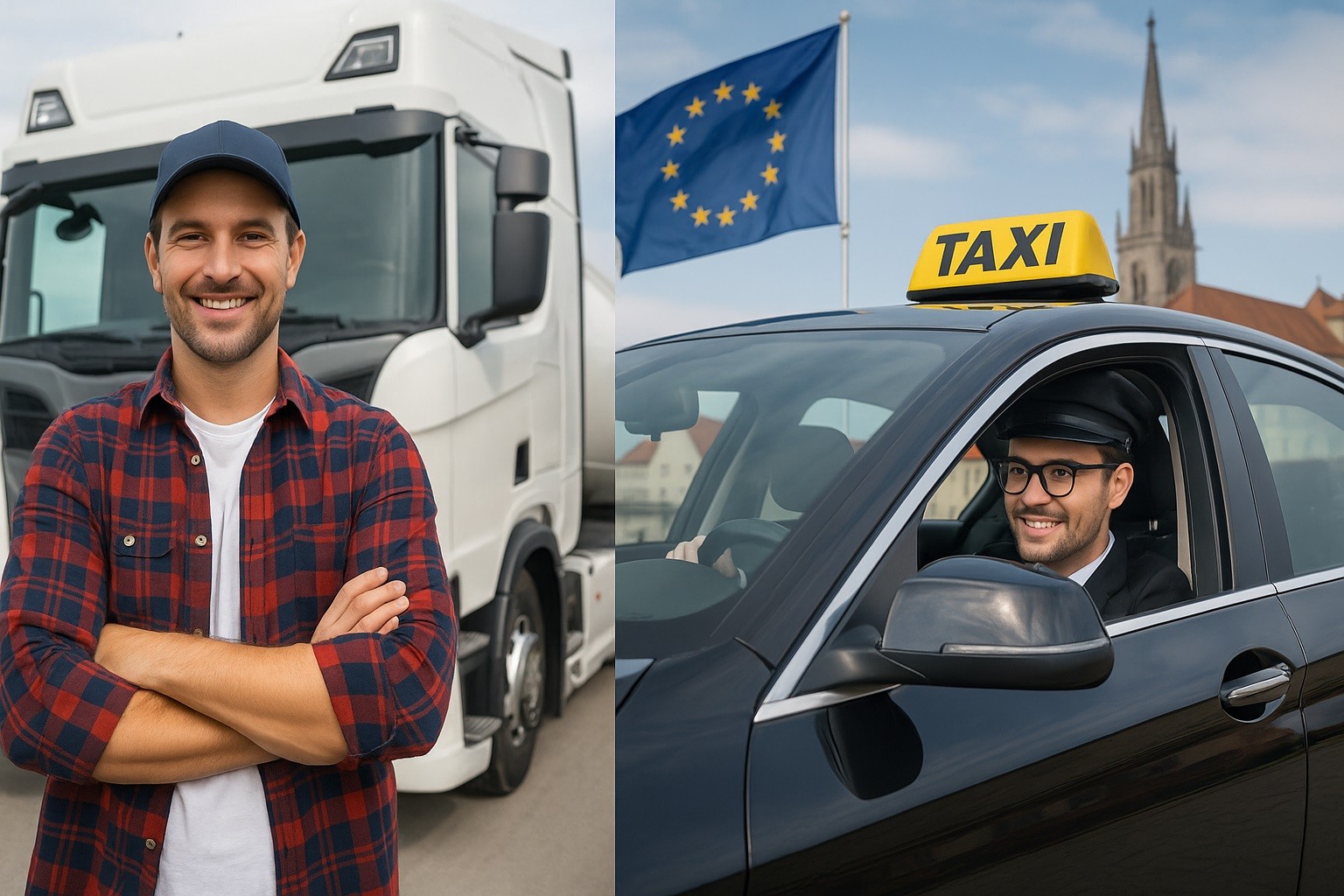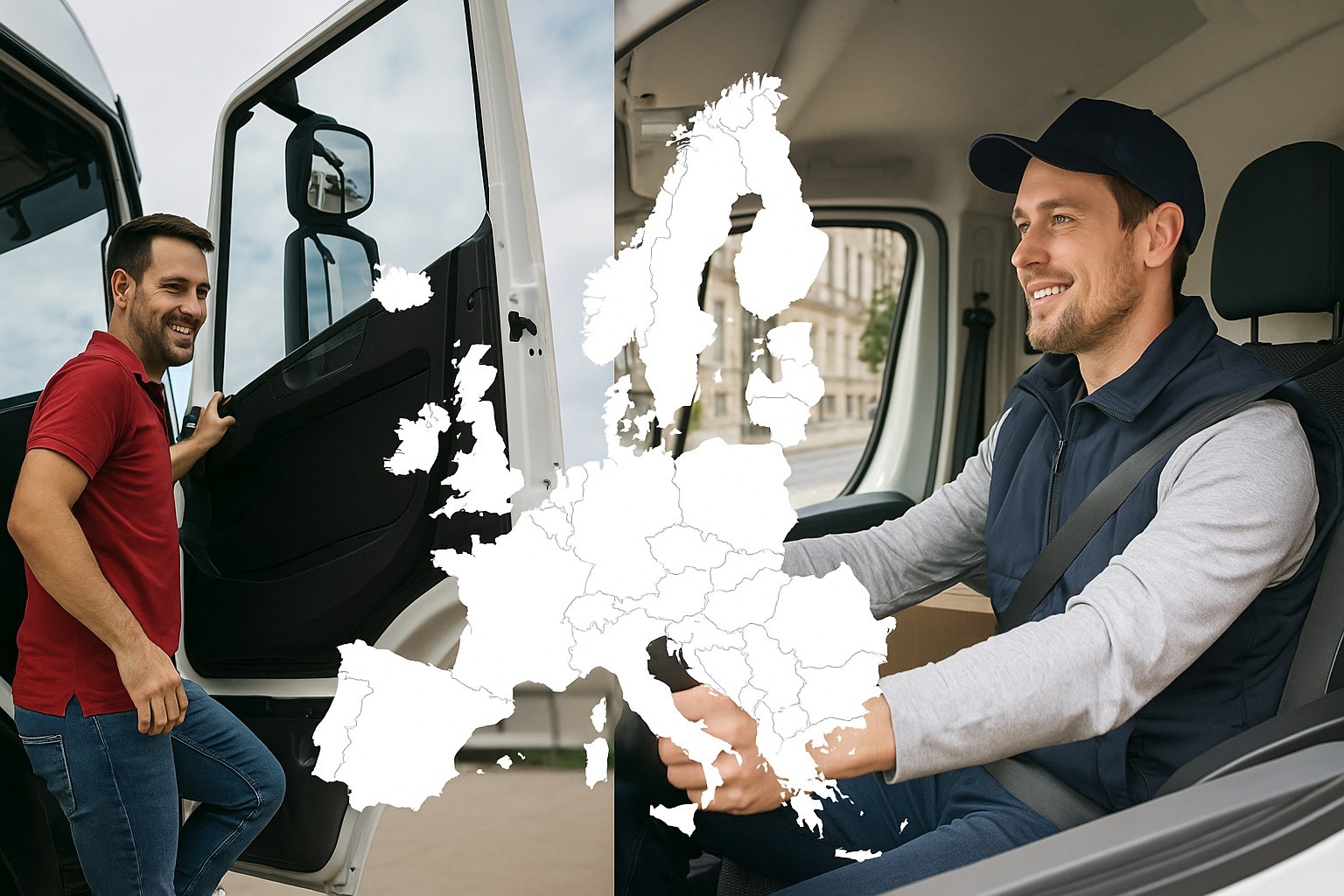Now is one of the best times to explore a driver jobs in Europe on the continent. This thanks to a growing shortage of qualified personnel, new regulations improving working conditions, and salary increases across countries.
The transport and logistics sector is booming across Europe, presenting excellent career opportunities for professional drivers.
Why Europe’s Demand for Drivers Is Surging
Driver jobs in Europe is gaining benefits from various modern advancements.
Acute driver shortage
The International Road Transport Union reported a shortfall of 233,000 professional truck drivers in Europe in 2023.
Projected to hit 745,000 by 2028 if no action is taken.
At the EU level, about 8.2 million people worked as drivers in 2022, accounting for a steady portion of the workforce CEDEFOP.
Aging workforce & poor recruitment
The average European truck driver is 47; nearly 30% are over 55, whereas only 5% are under 25 and fewer than 5% are women.
This significant generational gap signals urgent replacement demand.
E-commerce boom & logistics growth
The pandemic accelerated e-commerce, driving courier, regional haulage, and long-distance transport needs.
Forecasts suggest a 10% annual growth in logistics through 2030.
Regulation-driven shifts
EU regulations (e.g., Hours-of-Service rules under EC 561/2006) govern maximum driving time and mandatory breaks.
Driving demand for reliable drivers equipped to comply.

Salary Snapshot: What Drivers Earn Across Europe
Driver jobs in Europe offer various earning prospects.
A. Pan-European Overview
Typical wage ranges: €1,600–€5,000 monthly gross, depending on country, role, and experience.
Top earner: Switzerland leads (~€5,477/month) due to high living costs and alpine routes eurowag.com.
B. Western & Northern Europe
| Country | Earnings (monthly, gross) | Notes |
|---|---|---|
| Luxembourg | €3,000–€3,200 | Strong social protections |
| Germany | €2,400–€2,600 (minimum); average €2,800 gross (~€2,200–€2,575 net) | Entry-level from €18/hour to €27/hour with seniority |
| France | €2,300–€2,500 | Includes shift allowances |
| Belgium | €2,500–€2,800 | Tax-heavy but high pay |
| Netherlands & Sweden | €2,400–€3,000 | Collective agreements apply |
C. Central & Eastern Europe
| Country | Earnings (monthly, gross) | Notes |
|---|---|---|
| Poland | €1,400–€1,600 (min) with average net €1,620–€2,083 thanks to bonuses; ERI: PLN 55,589/year (~€12,000) or ~€27/hour | Younger drivers may earn more |
| Romania | €1,200–€1,400 | Plus benefits |
| Bulgaria | €1,000–€1,200 | Lowest EU wages |
D. Average Annual Figures
Germany: €30,653/year (€15/hour)
Poland: PLN 55,589/year (~€12,000), ~PLN 27/hour
E. Notable Quotes
Germany: Entry-level ~€18/hour, experienced up to €27/hour; average gross €2,800/month (€2,200–€2,575 net)
Poland: 69% earn more than PLN 7,000 net (€1,620), 23% exceed PLN 9,000 (~€2,083)
Trends Impacting Driver Jobs in Europe
2025 is changing the landscape of driver jobs in Europe.
Wages on the rise
Across the UK, NL, Germany, and France, wages climbed in spring 2025 by 1.9%–5.5% year‑on‑year.
Salary forecasts to 2025 show steady growth due to demand and regulation.
Better working conditions
New EU laws aim to improve driver welfare: more frequent breaks, working-hour caps, and mandatory “Code 95” certification for professional drivers.
Recruitment incentives
Countries like Poland, Germany, Luxembourg, and France have initiated visa sponsorships, bonus programs, and training subsidies.
Automation on the horizon
Autonomous driving technologies are emerging.
While long-term effects remain uncertain (fully automated trucks are still years away), digitization already demands higher technical skills from drivers .
Last‑mile & gig options
Delivery drivers in urban and suburban markets—often via platform-based gigs—are seeing growth.
In Poland, app-driven delivery services are gaining ground.
For these roles: entry-level pay starts around €1,500–2,000 depending on demand, with scope for tipping and bonuses.
Getting Started: Steps into a Driving Career
Earn driver jobs in Europe with structured plans.
Choose your niche
Heavy goods/long-haul (trucks, lorries): Requires HGV/Half-Jobs licences (e.g., European Code 95 or Germany’s C‑license).
Local delivery/courier: Lighter licence—ideal for beginners or part-timers.
Gig/last-mile: Platform-based with flexible hours and minimal barriers to entry.
Earn the right licences
Each EU country recognizes the common Code 95. Standards vary slightly per nation but include: Medical exam, CPC training (~35 hours), theory and practical tests
Check language & residency rules
EU citizens can work across borders. Non-EU drivers may benefit from sponsorship programs in nations like Poland, Germany, Luxembourg, and France .
Target high-demand countries
Western Europe—Germany, France, Luxembourg, Austria—offers the highest pay. Eastern Europe suits new drivers looking to train and gain experience more affordably.
Network & research employers
Top employers in Germany include DHL Freight (€40,000–€55,000/year), France’s Geodis (€35k–€50k), and UK’s Eddie Stobart (£30k–£50k) .
Career Outlook & Growth Opportunities
Compliance and safety-focused upgrades (e.g., ADR for hazardous goods, refrigerated transport) add value and increase earning potential.
Many drivers advance to roles in logistics coordination, fleet management, or driver education/training. Some even launch their own SMEs.
Between 2022–2025, the EU anticipates 5.2 million job openings due to retirements and growth.
Despite automation and EV transitions, demand for skilled drivers will endure for years.
Tips for Aspiring Drivers
To search for driver jobs in Europe, follow the following advice.
- Budget for training: Licences and certifications can cost €1,000–2,000. Some employers subsidize these.
- Prioritize quality employers: Look at pay rates, shift patterns, and extra benefits like accommodation and bonuses.
- Be flexible: Long‑haul roles are better paid but require travel. Regional roles offer more home time.
- Keep your licence valid: Continuous CPC/Code 95 training is mandatory.
- Adapt to trends: Familiarize yourself with digital logbooks, route tracking, and early automation tech.

Starting your journey
Get a clean driving record, basic licence, and medical check. Enroll in accredited CPC/Code 95 training.
Research visa or sponsorship schemes (especially if you’re non-EU)
Explore reputable providers (e.g., DHL Freight, Geodis, national logistics firms)
Apply, network, and prepare for interviews addressing regulations, safety, and compliance.
Conclusion
With Europe’s logistics sector growing ~10% annually and severe shortages expected to persist.
Driver careers present a rare blend of demand, reward, and opportunity.
The road ahead is particularly promising for those willing to get certified, remain adaptable, and navigate regulatory frameworks.












